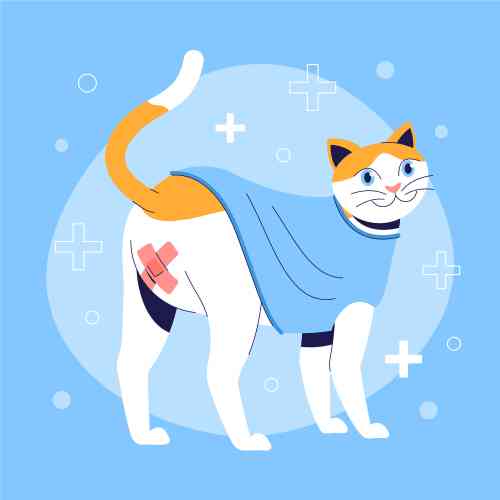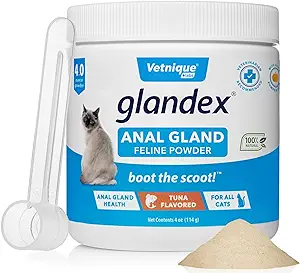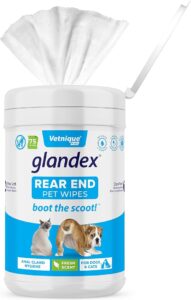There is a bump on your cat’s anus – What can you do?
A bump on your cat’s anus is always something that scares you as an owner. Unfortunately, this can be something serious, but fortunately it is rarely life-threatening. In this article we describe what could be the cause of the bump on your cat’s anus. And we explain how you can recognise it yourself. Some things you can’t solve yourself, but we will give you advice on what you can do to treat the bump on your cat’s anus.
Healthy anus of a cat
A healthy cat’s anus is normally kept clean by your cat. It is not often that your cat has a dirty anus. In addition, the anus is usually light pink in color, although some cats also have some pigmentation in their anal skin. In that case you will see a gray-black color. And a spotted anus also occurs. Right next to the anus opening are small glands, the anal glands. These should not be puffy and should not contain black dots. The anus should be in a relaxed position, but closed. You should not see a bump on your cat’s anus. Your cat should also not lick it excessively or rub the ground with it.

How do you recognize a bump on your cat's anus?
This seems like an easy task, but sometimes it isn’t. In principle, you can easily recognize a bump on your cat’s anus if it is more superficial and clearly rises above the surface of the skin. But in some cases, the bump on your cat’s anus is much deeper. In that case you won’t see it right away. You will then see that the anus opening is not directly in the middle of the buttocks. The anus is pushed to the side by the larger bump.
Symptoms of a bump on your cat's anus?
In addition to the bump on your cat’s anus, you may also notice that your cat experiences some irritation. He may lick it excessively or rub the ground with his anus. You may also notice that the bump looks red or is painful. It may possibly smell a bit. In some cases, your cat may also not be completely fit in general. In that case he may have a fever, behave lethargic or eat and drink poorly.
Possible causes of a bump on your cat's anus
In the vast majority of cases, a cat has a bump on its anus as a result of an abscess. We also often see inflammation of the anal glands in a cat. An anal prolapse is not so much a bump on the anus, as the anus itself comes out. Yet people often report seeing a bump on their cat’s anus when they take it to their vet. We also have the polyps and the tumors. Below we discuss these causes in more detail.
Abscess due to fighting
If your cat has had a difference of opinion with another cat, it may have been scratched. Since one of the two cats almost always runs away, it is quite possible that the scratch ended up next to the anus. At that moment, bacteria from the other cat’s nail has also been introduced under your cat’s skin. They will multiply and your cat’s body will try to clean the bacteria up with pus cells.
At that location, under the skin, a cavity is created that is filled with pus and bacteria. This shows up as a bump next to your cat’s anus. An abscess usually develops in about 2-3 days and is quite painful. After about 3-4 days the bump has grown so big that it bursts open and a lot of mess comes out of that opening.
Inflamed anal glands
Next to the anus opening there are very small glands in the skin. We also call these the anal glands. These small glands make the substance that cats put on their poop so that they can mark a territory. When the opening is blocked in some way, an anal gland can become thickened and swell. Next to the anus you will see a bump of approximately 0.5 to 1 cm. These anal glands can also become inflamed, causing the lump next to your cat’s anus to become even larger. The latter happens very regularly in dogs, but less often in cats.
Because they experience a bit of an unpleasant feeling at the bump on the anus, they may also lick that region a lot. Or they rub their buttocks on the ground. In general, it is quite easy for you as the owner to empty the anal glands to relieve the pressure your cat is feeling. But it’s a dirty job. Your cat will then be less bothered by the bump on his anus, the bump will be smaller after emptying and after a day or two the bump will have disappeared completely.

Anal prolapse
An anal prolapse is not really a bump on the anus. With an anal prolapse, the rectum comes out via the anal opening. You recognize this as a somewhat dark red mass that comes out through the anal opening. This can be half a centimeter, but also 5 centimeters. The more that comes out, the more serious the problem is.
An anal prolapse almost always occurs as a result of an underlying problem that causes a cat to have an increased urge to strain. So in case of diarrhea, constipation, a bladder infection or during the birth process of kittens.
Do you think your cat may have an anal prolapse? Then it is necessary to go to your vet urgently. So even if it is an evening or weekend. Your cat’s intestines receive less blood and will therefore die off if this takes too long. And without treatment, your cat will very likely die.
Polyps
If you see a bump on your cat’s anus that is about 1 to 2 millimeters in size and looks a bit like a mushroom, it is probably a polyp. These can grow internally in the intestine and then “squeak” outward. They bleed quite easily, and often irritate your cat quite a bit. But they can’t really do much harm. They almost never become cancerous in this region. Still, you’d better have them removed. This is done surgically as they do not disappear on their own. After all, your cat suffers from it.
Very occasionally, if the polyp is easily accessible from the outside, we can also cut it off very quickly with a special scalpel without anesthesia. The base of the polyp is still there, but since it often takes months before it grows back, this may be the most convenient solution for some cats at that time. Especially if your cat is already elderly and anesthesia is extra dangerous.
Tumor
A bump on your cat’s anus can of course always be a tumor. But this is extremely rare in cats. In that case, a tumor often forms a kind of wound that does not heal. And in the area of the anus this can of course become infected very easily, resulting in significant inflammation.
Can a cat also have hemorrhoids?
Hemorrhoids are bulges of blood vessels in and around the anus. Even though cats naturally have these blood vessels, hemorrhoids are virtually non-existent in cats. If you see a red raised bump around your cat’s anus that is reminiscent of hemorrhoids, this is usually an inflamed anal gland. Or some other kind of inflammation. Of course, it can be just as irritating for your cat, but your cat will not get a real hemorrhoid.

When should you go to the vet with a bump on your cat's anus?
First of all, look at the bump carefully. This can be difficult. Cats don’t want you to look at their anus. And especially not when it bothers them. Is the bump extremely painful to touch and is it next to the anus? Then it is probably an abscess. You can read what to do on the page about an abscess in cats. Does your cat really not like it and is it very painful? Then it is best to go to your vet.
Do you see a dark red cherry-like bulge coming out of your cat’s anus? Then it is probably an anal prolapse. In that case, you should take your cat to your vet as soon as possible. It is also best to have a polyp assessed by your vet, but this is less urgent than an anal prolapse.
What can you do yourself about a bump on your cat's anus?
Do you see a small bump next to the anus that is not too painful? In that case it is probably an overfilled anal gland. You can take a piece of toilet paper and try to squeeze the bump like a pimple. You should gradually increase the pressure from the side to the center of the bump. Your cat will find this a little uncomfortable, so it’s best to do this in pairs. The other person can then hold your cat and distract him, while you try to squeeze out the lump on your cat’s anus. Usually, emptying the anal glands is not difficult. Once the anal gland has been emptied you should be left with a much smaller lump. The bump will probably shrink even further in the following days. Unfortunately, over time his anal gland will fill up again and you will have to empty it again.
If your cat regularly suffers from his anal glands, it is wise to give him Glandex with his diet. This prevents the anal glands from overfilling, making the anal glands less likely to form a bump on your cat’s anus. Keep in mind that cats are very picky about their diet. So start with a very small amount of powder added to his food and increase the dosage over a long period of time so that your cat can get used to the taste. Good luck!


